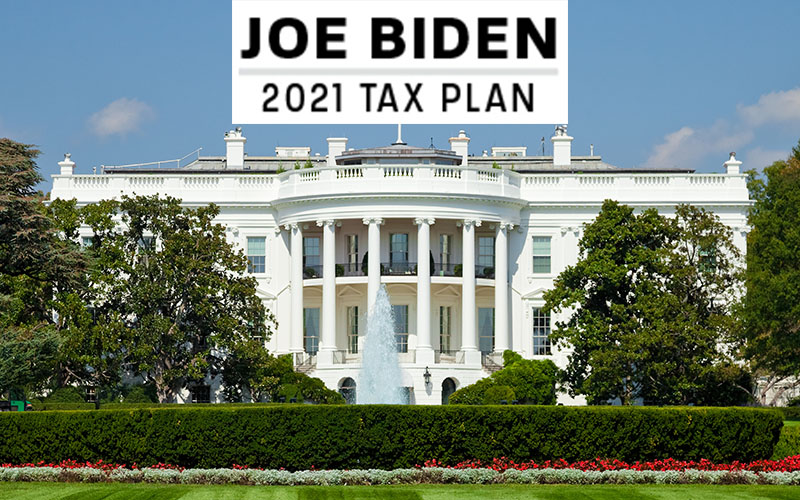Even if the Democrats gain control of the Senate by winning both runoffs, the odds of dramatic tax reform may still be low. Some Democratic Senators, who will be up for re-election in 2022, may be reluctant to support a tax-increase agenda in the current COVI D-19-ravaged environment. The same may be true for at-risk Democratic House members who will be up for re-election in 2022.
All things considered, it could be a daunting task to get significant federal tax changes through Congress in 2021 or 2022. With that thought in mind, this letter addresses the most important proposed federal tax changes found in the Biden tax plan. Note that specifics for the proposals are often lacking, but we would be happy to meet with you to discuss how possible changes could affect your tax situation.
Higher Maximum Individual Tax Rate
Biden proposes to raise the top individual rate on ordinary income and net short-term capital gains to 39.6%, which was the top rate before tax reform lowered it to 37% for 2018-2025. However, Biden has stated that he would not increase taxes “on anyone making less than $400,000 a year.” It’s unclear if that figure pertains to taxable income, gross income, or adjusted gross income. It’s also unclear if the $400,000 threshold would apply equally to singles, heads of household, and married joint-filing couples.
Limit on Tax Savings from Itemized Deductions
The Biden plan would limit the tax benefit of itemized deductions to 28% for upper-income individuals. In other words, each dollar of allowable itemized deductions could not lower your federal income tax bill by more than 28 cents, even if you are in the proposed 39.6% maximum tax bracket.
Also, for upper-income individuals, Biden would reinstate a prior rule that reduced total allowable itemized deductions above an applicable income threshold. Allowable deductions would be reduced by three cents for every dollar of income above the threshold.
Note: It appears that Biden favors the repeal of the current $10,000 cap on itemized deductions for state and local taxes. This proposal could be met with bipartisan support.
Higher Maximum Tax Rate on Individual Long-term Capital Gains
Higher-income individuals also would face increased federal capital gains taxes under the Biden plan. Under current law, the maximum effective federal income tax rate on net long-term capital gains and qualified dividends recognized by individual taxpayers is 23.8%. That is comprised of the 20% top rate plus another 3.8% for the Net Investment Income Tax (NIIT).
Under the proposed Biden plan, net long-term capital gains (and presumably qualified dividends) collected by those with incomes above $1 million would be taxed at the same 39.6% proposed maximum rate that would apply to ordinary income and net short-term capital gains. With the 3.8% NIIT add-on, the maximum effective rate on net long-term capital gains would be 43.4% (39.6% + 3.8%). That would be almost double the current maximum effective rate of 23.8%.
Higher Social Security Taxes for Upper-income Individuals
Under current law, the 12.4% Social Security tax hits the first $137,700 of 2020 wages or net selfemployment income. That figure increases to $142,800 for 2021. For 2022 and beyond, the Social Security tax ceiling will be adjusted annually for inflation. Employees pay 6.2% via withholding from paychecks, and employers pay the remaining 6.2%. Self-employed individuals pay the entire 12.4% out of their own pockets via the self-employment tax.
The Biden tax plan would restart the 12.4% Social Security tax on wages and net self-employment income above $400,000. This is the so-called donut hole approach to increasing the Social Security tax. Over the years, the donut hole would gradually close as the lower rim of the hole is adjusted for inflation while the $400,000 upper rim of the hole remains static.
Elimination of Basis Step-up for Inherited Assets
Under current law, the federal income tax basis of an inherited asset is stepped up to fair market value as of the decedent’s date of death. So, if heirs sell inherited capital-gain assets, they only owe federal capital gains tax on the post-death appreciation, if any. This provision can be a huge tax-saver when we are talking about a greatly appreciated inherited asset, such as a personal residence that was acquired many years ago for next to nothing and is now worth millions. The proposed Biden tax plan would eliminate this provision.
Elimination of Certain Real Estate Tax Breaks
The proposed Biden tax plan would (1) eliminate the $25,000 exemption from the passive loss rules for rental real estate losses incurred by certain individuals, (2) eliminate like-kind exchanges that allow deferral of capital gains taxes on swaps of appreciated real property, (3) eliminate faster depreciation write-offs for certain property, and (4) eliminate Qualified Business Income (QBI) deductions for profitable rental real estate activities.
Observation: Given that commercial real estate values are already threatened by COVID-19-related economic fallout, it may be difficult to push these legislative changes through Congress.
QBI Deduction Phaseout
For 2018-2025, current law allows individuals, estates, and trusts to claim a deduction of up to 20% of QBI from sole proprietorships, LLCs, partnerships, and S corporations. However, once a taxpayer’s taxable income exceeds a certain threshold, the deduction becomes subject to various limitations/phaseouts that depend on the nature of the taxpayer’s business and its wages and/or qualified property. For 2020, the taxable income threshold is $326,600 for joint filers and $163,300 for all other filers. For 2021, the threshold increases to $329,800 for joint filers, $164,925 for married individuals filing separately, and $164,900 for all other filers.
Under the Biden tax plan, the QBI deduction would be phased out for filers with taxable income above $400,000.
More Generous Child and Dependent Care Credits
Child Tax Credit. Under current law, parents can collect a tax credit of up to $2,000 for each qualifying child younger than 17. Certain parents can treat a portion of their credit as refundable, meaning they don’t need to have any federal income tax liability to collect the credit. In other words, a portion of the credit is considered “free money.”
The Biden tax plan would increase the credit amount to $3,000 per child for children ages 6 to 17. For children younger than 6, the credit amount would be slightly higher at $3,600 per child. In addition, Biden would make the child tax credit fully refundable, presumably to help with the economic effects of the COVID-19 pandemic.
Child and Dependent Care Tax Credit. Under current law, a nonrefundable credit is available to working taxpayers who incur and pay child and dependent care expenses. The credit equals a percentage (generally between 20% and 35%) of the lesser of (1) the amount of qualifying child and dependent care expenses, limited to a maximum of $3,000 for one qualifying person or $6,000 for two or more qualifying persons, or (2) the taxpayer’s earned income (or spouse’s earned income if less).
Biden would offer a more generous credit of up to $8,000 for one child or $16,000 for two or more children to help lower-income and middle-income working families afford child care. Biden also would make the credit fully refundable.
Credits for Health Insurance Costs
Biden would offer refundable tax credits to help working families afford health insurance. The goal is to ensure that no family spends more than 8.5% of their income on health insurance premiums. It appears there could be bipartisan support for something like this.
Credit for Homebuyers
The Biden plan would create a new refundable tax credit of up to $15,000 for eligible first-time homebuyers. The credit could be collected when a home is purchased, rather than later at tax-return filing time. This is another provision that could garner bipartisan support.
Equalizing Tax Benefits from Retirement Plan Contributions
Under our current federal income tax system, the tax benefits from making retirement plan contributions are bigger for upper-income taxpayers. The Biden plan would “equalize benefits across the income scale, so working families also receive substantial tax benefits when they put money away for retirement.”
Higher Corporate Taxes
One of the biggest changes that came out of 2017 tax reform was the installation of a flat 21% corporate federal income tax rate for 2018 and beyond. Prior to 2018, the maximum effective rate for profitable corporations was 35%. The Biden plan would increase the corporate tax rate from 21 % to 28%.
The Biden plan also would impose (1) a 21 % minimum tax on all foreign earnings of U.S. companies located overseas and (2) a tax penalty on corporations that ship jobs overseas in order to sell products back to America.
New Corporate Minimum Tax
The Biden plan would impose a new 15% minimum tax on corporations with more than $100 million in annual income that pay little or no federal income tax under the “regular rules.” An affected corporation would pay the greater of (1) the “regular” federal income tax bill or (2) 15% of reported book net income.
New Financial Risk Fee for Big Financial Institutions
Biden would introduce a so-called financial risk fee for banks, bank holding companies, and nonbank financial institutions with over $50 billion in assets. The fee would be based on an institution’s covered liabilities and would provide the Federal Deposit Insurance Corporation (FDIC) with a pool of funds to pay for FDIC-insured deposits held in failed institutions.
“Green Energy” Tax Changes
Biden would reinstate or expand tax incentives intended to reduce carbon emissions, such as deductions for emission-reducing investments in residential and commercial buildings and restored credits for buying electric vehicles produced by manufacturers whose credits have been phased-out under current law. Also, Biden would eliminate federal income tax deductions for oil and gas drilling costs and depletion.
Conclusion
This letter summarizes what we think are the most important announced proposals in the Biden tax plan. Other proposed changes will probably be advanced once the new Administration and the new Congress are in place. Finally, you never know what unexpected developments will occur next and how taxes might be affected. Please contact us if you have questions or want more information about what we know now.
Sincerely,
CPA Advisory Group
If you any have questions about planning your charitable deductions, business taxes or personal finances, contact the experts at Pinnacle CPA Advisory Group for help. Call us at (614) 942-1990, email info@cpaagi.com, or fill out our website Contact Form at cpaagi.com/contact.
Other recent posts from our blog
Contact Us
Do business with a different kind of CPA firm – the CPA Advisory Group
Email Us
Call Us
Visit Us
131 Dilmont Dr., Suite 200
Columbus, OH 43235
CPA Advisory Group, Inc.
Leading Small Businesses and Individuals to Success






